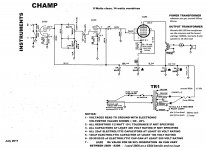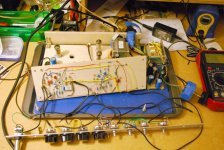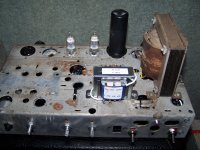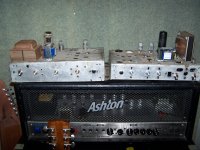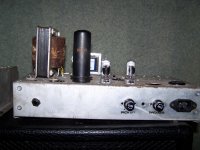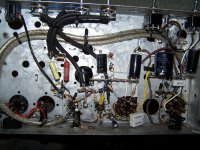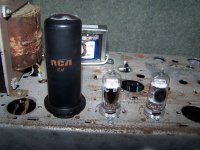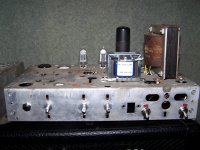Hmm thinking of going electric someday. It should be another year before I deserve a reward! So is this the competition?
https://www.vintageguitar.com/23716/mod-kits-diy-102-amp-kit/
Someday maybe we could have a board in the store? I think it would be great. Same rules as recently discussed : weird is ok as long as it's easily obtainable...
Sub $200ish build? Am I right that there are about 3 appealing designs?
https://www.vintageguitar.com/23716/mod-kits-diy-102-amp-kit/
Someday maybe we could have a board in the store? I think it would be great. Same rules as recently discussed : weird is ok as long as it's easily obtainable...
Sub $200ish build? Am I right that there are about 3 appealing designs?
Last edited:
not a comp ...but
There is always a few ways of getting the job done....the way I look at it is that there are so many popular schematics available for all the favorite amp builds...marshal , fender , vox and the list goes on.....
NOS tubes for these amps are getting expensive which means that ultimately you are gonna go Russian / Chinese for tubes (which can only improve over time) or pay the big $$$......thing is , there are alternatives which will fit right in with these schematics
Example , a 12ax7 is just 2 triodes in a bottle and a 6av6 is a single triode in a bottle (with 2 diodes , just connect them to cathode)...both have gain factors of 100.....to get a mullard 12ax7 your gonna pay lots $$$ .... but to get a NOS 6av6 you can do it for coffee money and the lesser 6at6 is the same only gain is 70 (similar to 12at7).....so you just wire them in with no change to the schematic ,put them in side by side...and easy to wire
Same with the 6ar6 close enough to a 6l6 all you do is wire the pins differently and presto.....1 beautiful sounding amp with quality all the way ...but with tubes at bargain prices
That is what I'm about.....simple alternatives that work well
Hmm thinking of going electric someday. It should be another year before I deserve a reward! So is this the competition?
https://www.vintageguitar.com/23716/mod-kits-diy-102-amp-kit/
Someday maybe we could have a board in the store? I think it would be great. Same rules as recently discussed : weird is ok as long as it's easily obtainable...
Sub $200ish build? Am I right that there are about 3 appealing designs?
There is always a few ways of getting the job done....the way I look at it is that there are so many popular schematics available for all the favorite amp builds...marshal , fender , vox and the list goes on.....
NOS tubes for these amps are getting expensive which means that ultimately you are gonna go Russian / Chinese for tubes (which can only improve over time) or pay the big $$$......thing is , there are alternatives which will fit right in with these schematics
Example , a 12ax7 is just 2 triodes in a bottle and a 6av6 is a single triode in a bottle (with 2 diodes , just connect them to cathode)...both have gain factors of 100.....to get a mullard 12ax7 your gonna pay lots $$$ .... but to get a NOS 6av6 you can do it for coffee money and the lesser 6at6 is the same only gain is 70 (similar to 12at7).....so you just wire them in with no change to the schematic ,put them in side by side...and easy to wire
Same with the 6ar6 close enough to a 6l6 all you do is wire the pins differently and presto.....1 beautiful sounding amp with quality all the way ...but with tubes at bargain prices
That is what I'm about.....simple alternatives that work well
That's an interesting one! I hadn't heard about that particular kit. It's about half the price of most valve amp kits I've seen!
There have been commercially available valve guitar amps at the $100 price point. The Kustom Defender 5h sold for about that price a few years ago. It was a 5-watt Fender Champ clone, with an EL84 and a 12AX7 in it.
The Kustom Defender 5h was mentioned on this thread, and may have contributed to some people abandoning their challenge amps.
Speaking for myself, I got involved with this thread because I wanted an amp that doesn't exist in commercial form. I wanted very low power (2-3 W max, adjustable down to milliwatts), push-pull output, and two completely independent switchable channels. A full-featured amp, but not too loud to use at home, or with friends playing acoustic guitars.
Even if my fairy godmother had given me $1000 to go buy an amp, I don't think I could have found what I was looking for. So the only remaining option was to design and build it myself. In my case, there is no (commercial) competition...perhaps not enough people want a low-power amp with a full complement of features?
-Gnobuddy
Go class A
6aq5 class A will give you what you want.....4.5 watts max....hardest part is getting a speaker to sound good at those watts (milliwatts).....no phase inverters to worry about and you can put as many channels in as you want
there is a whole bunch of 6aq5's that sound slightly different from each other and you can afford to get as many as you want...I like the black plates myself
5aq5's even cheaper....rifraf
6aq5 class A will give you what you want.....4.5 watts max....hardest part is getting a speaker to sound good at those watts (milliwatts).....no phase inverters to worry about and you can put as many channels in as you want
there is a whole bunch of 6aq5's that sound slightly different from each other and you can afford to get as many as you want...I like the black plates myself
5aq5's even cheaper....rifraf
Last edited:
Attachments
Last edited by a moderator:
I do like the single-ended sound for cleans and mild overdrive. But for heavier overdrive, all the amps I like seem to have push-pull output stages.6aq5 class A will give you what you want...
What I've actually built so far has a push-pull output stage, which overdrives nicely (to my ears). A bit earlier in the signal chain, in the preamp, there's a small-signal pentode, operating in class A, whose job is to provide nice single-ended clean tones and mild overdrive.
The idea is that, as gain is turned up, there will be a transition from those nice single-ended cleans and mild overdrive, into push-pull output stage overdrive. If I get the levels right, the output stage will go into it's typical (symmetrical) clipping before the single-ended preamp pentode gets into harsh territory.
The hope is to get the best of both worlds - it should sound like a single-ended class A amp for cleans, and overdrive like a good push-pull amp.
So true!...hardest part is getting a speaker to sound good at those watts (milliwatts)...
The room has a lot to do with it, too. We used to jam in a large room with hard floor, hard walls, a gigantic glass window, and no furnishings. Lots of natural room reverb - my guitar amp sounded pretty good in that room!
That building got sold, and we lost the use of that room. Now we jam in a basement. Soft couches, carpeted floor, wooden beams supporting the ceiling, an irregular floor plan, etc. This room is very acoustically dead, and it took a lot of life out of the sound of my guitar amp.
-Gnobuddy
Just sharing a picture of my amp, in its current state. Eight pots on the (temporary) front panel, plus an Lpad off to the right side...it's definitely not a Champ!
This is a 2-channel amp, four knobs for each channel. Gain, bass, treble, master volume for cleans, then the same four controls for the drive channel. Pretty simple and logical.
There are two circuit boards (literally, they are plywood.) The one in the foreground carries two 6JW8 triode-pentode valves, which together make up the two channels of the preamp.
Since I wired up the drive channel, there is lots of hum (at all volume and gain settings). I probably accidentally introduced a ground loop, which is rather easy to do with shielded cable. I need to find and fix it.
Apologies for the messy workbench. Fortunately for me, that seems to be par for the course on this thread!
-Gnobuddy
This is a 2-channel amp, four knobs for each channel. Gain, bass, treble, master volume for cleans, then the same four controls for the drive channel. Pretty simple and logical.
There are two circuit boards (literally, they are plywood.) The one in the foreground carries two 6JW8 triode-pentode valves, which together make up the two channels of the preamp.
Since I wired up the drive channel, there is lots of hum (at all volume and gain settings). I probably accidentally introduced a ground loop, which is rather easy to do with shielded cable. I need to find and fix it.
Apologies for the messy workbench. Fortunately for me, that seems to be par for the course on this thread!
-Gnobuddy
Attachments
6aq5 class A will give you what you want.....4.5 watts max....hardest part is getting a speaker to sound good at those watts (milliwatts).....no phase inverters to worry about and you can put as many channels in as you want
there is a whole bunch of 6aq5's that sound slightly different from each other and you can afford to get as many as you want...I like the black plates myself
5aq5's even cheaper....rifraf
How about some NOS 6V6's? For a princely sum of $4.00 a piece? One catch, heaters run at 12.6V. Probably worth picking up a bunch to last you for years to come. Use a separate transformer if you like, can always slap in a 6V one if you want to slum it and go to Chinese or Russian. And no, I doubt they can only get better.
Now, that's just cruel, tempting an addict like that!How about some NOS 6V6's? For a princely sum of $4.00 a piece?
I doubt that, too.And no, I doubt they can only get better.
Personally, I feel as though the bottom is about to fall out of the current valve/tube manufacturing industry any minute now.
There are many convergent factors:
- Our old rock and blues guitar heroes are rapidly heading off to the promised land, one by one, and with them, the sounds they made, and the influence they exerted on tens of thousands of everyday musicians.
- The people who still care about manufacturing, warehousing, and selling valves are also, um, entering their golden years. They won't be around much longer.
- Analog electronics designers, and analog-specific electronics components, are starting to disappear from the market. It's getting harder to find even basics like log pots, or ganged (stereo) pots. Never mind audio output transformers, high-voltage power transformers, etc.
- Guitar sounds are rapidly disappearing from current popular music, which consists mostly of electronically generated noises (EDM). The popularity of the guitar itself among youth seems to be dropping.
- For many current guitarists who like harsh, heavy distortion, digitally modelled amps produce the sounds they want - and they're smaller, lighter, cheaper, and more reliable than valve amps, and give you more knobs and buttons and menus to tinker with. A perfect fit for the Android/iPhone generation!
I guess that's all the more reason to have as much fun as possible with threads like this one. If the current-production valves disappear, those of us willing to tinker with oddball valves that were never used by Fender or Marshall, will be the only ones still able to build and maintain valve guitar amps.
-Gnobuddy
Fixed it. No ground loop, I just forgot to ground the metal strip acting as my front panel!...Since I wired up the drive channel, there is lots of hum (at all volume and gain settings). I probably accidentally introduced a ground loop...
There's still a light buzz, which may be radiated noise from the HT power supply. I may have to put it in a metal box.
-Gnobuddy
hi,fellow tube addicts !
I got this second one built.....used a metal 6l6,bought 2 for 12 bucks as is and they were still in the box so I assumed they were new.....but for $12 gonna risk it !
Ive run these before...actually still am in a bluesbreaker copy with lowered plate volts and they actually sound very very good despite what others say...only hangup is you cant look inside to see if they are going ballistic...and its possible volts can touch the sides....but mine are enclosed...also pin 1 is connected to the can.....but a $6 NOS RCA 6l6 !
2nd build didn't have as many volts as 6ar6 one...400v as opposed to 340v
but no noticeable drop in volume.
I think the M1120 transformer is a little shy of bass in both units but more can be done to bring it forward......ran them both in stereo effect mode and they were quite loud....possibly loud enough to gig with but not the cleans though...... although rolling the volume off the guitar puts it in nice middle ground but with a dedicated transformer I think a little more noise and a little more bass would make it through
I thought about adding reverb and vibrato but I control most things at my feet these days so slaves are really all I need.....no tricks !
This amp cost me about the same as the other one and sounds as good as the other one.....one thing I did notice was the different tones that came from the assortment of 6av6's I have here...in Australia they are in everything mono radio or gramophone
one last word on 6aq5 (7 pins).....they are actually 6v6 in a little bottle limited to 250v so the sides don't melt and the 6bw6 (9 pins)is rated to 315v I think and exclusively made by brimar....both 6v6 derived...
regards rifraf50
I got this second one built.....used a metal 6l6,bought 2 for 12 bucks as is and they were still in the box so I assumed they were new.....but for $12 gonna risk it !
Ive run these before...actually still am in a bluesbreaker copy with lowered plate volts and they actually sound very very good despite what others say...only hangup is you cant look inside to see if they are going ballistic...and its possible volts can touch the sides....but mine are enclosed...also pin 1 is connected to the can.....but a $6 NOS RCA 6l6 !
2nd build didn't have as many volts as 6ar6 one...400v as opposed to 340v
but no noticeable drop in volume.
I think the M1120 transformer is a little shy of bass in both units but more can be done to bring it forward......ran them both in stereo effect mode and they were quite loud....possibly loud enough to gig with but not the cleans though...... although rolling the volume off the guitar puts it in nice middle ground but with a dedicated transformer I think a little more noise and a little more bass would make it through
I thought about adding reverb and vibrato but I control most things at my feet these days so slaves are really all I need.....no tricks !
This amp cost me about the same as the other one and sounds as good as the other one.....one thing I did notice was the different tones that came from the assortment of 6av6's I have here...in Australia they are in everything mono radio or gramophone
one last word on 6aq5 (7 pins).....they are actually 6v6 in a little bottle limited to 250v so the sides don't melt and the 6bw6 (9 pins)is rated to 315v I think and exclusively made by brimar....both 6v6 derived...
regards rifraf50
Attachments
I did notice was the different tones that came from the assortment of 6av6's.....in Australia they are in everything
They were pretty common in the USA too, although the 12AV6 from the AA5 series heater radios were more common. There are two other flavors, the 6AT6 and the 6AQ6, both with less gain, but will drop in to most 6AV6 circuits for more tonal variations.
6AQ5.....they are actually 6v6 in a little bottle limited to 250v so the sides don't melt
Much smaller plates that the 6V6, but electrically quite similar. The 6AQ5 has a unique failure mode that I have never seen in another tube. The glass is only a few mm away from the plate. Most of the little 7 pin output tubes are rated for 5 or 6 watts of plate dissipation. The 6AQ5 is rated for 10 or 12 watts depending on whose data you read, and which application the tubes are used in.
There is a very fine line between red plate and hole in the glass. Ideally a tube will dissipate its power evenly across the surface of the plate. This requires perfect alignment of everything inside the tube, which doesn't happen. The 6AQ5 usually red plates in one small spot on one side. This softens the glass, and the vacuum sucks the soft spot inward. As the soft spot gets closer to the plate, a crater forms, and the bottom melts, sucking air into the tube.....silence ensues!
If the plate dissipation is kept below 10 watts, you can bend the 250 volt rating a bit.
6bw6 (9 pins)is rated to 315v I think and exclusively made by brimar
In the USA there is the 12AB5, designed for car radios. Good for 315 volts also.
6aq5 amps
I have made 4 6aq5 amps 2,super SE Angella amps.... 1, 10 watt and 1 , 18 watt
the Angela Super SE was a big hit with my friends...so I gave them to them...surprisingly loud....running 270v on the plates
the 10 watt had nicer cleans than the SE but for some reason I just never used it so I gave it away (not really loud enough for rehearsals )
And the 18 watt was troublesome with oscillations ,but I could see the potential (pre DIY).....but that was in my development stage of learning and building......I know a lot more now so I would probably do a better job of it (ended up as a quad of pl84..and is my current rehearsal amp )....4 tubes from Italy $16...looked like Telam's
I used voltage multipliers on all of them as cheap supplies and never had issues
Knowledge and practice go hand in hand....just gotta stay with it.....
I have made 4 6aq5 amps 2,super SE Angella amps.... 1, 10 watt and 1 , 18 watt
the Angela Super SE was a big hit with my friends...so I gave them to them...surprisingly loud....running 270v on the plates
the 10 watt had nicer cleans than the SE but for some reason I just never used it so I gave it away (not really loud enough for rehearsals )
And the 18 watt was troublesome with oscillations ,but I could see the potential (pre DIY).....but that was in my development stage of learning and building......I know a lot more now so I would probably do a better job of it (ended up as a quad of pl84..and is my current rehearsal amp )....4 tubes from Italy $16...looked like Telam's
I used voltage multipliers on all of them as cheap supplies and never had issues
Knowledge and practice go hand in hand....just gotta stay with it.....
Last edited by a moderator:
Got more than a handful of PL84's, or 15CW5's. Have some 8CW5's also, just put the heaters in series if I run out. The 12AB5's can take a lot more than 315V, have 390V on a set. Mind you I have a fair amount of sag and they drop the supply passing square waves (originally was a sine wave) to 355V if I remember correctly. Harman Kardon ran them about 440V in an integrated amp, hifi though.
So would this work? Forgot to add the diodes for input protection. Not concerned of the tube part, looking to feed it into a Class D amplifier.

So would this work? Forgot to add the diodes for input protection. Not concerned of the tube part, looking to feed it into a Class D amplifier.

I would do away with the phase inverter ...and just put another gain stage in......this is a preamp feeding a class d amp ? does the power amp already have its own phase inverter......not sure what your trying to do.....
I want it to sound like a Marshall, part of the sound is the PI.
A lot of the character comes from the beginning to the end....the preamp,the power tubes, the transformer and the speaker.....the musicman amps had a solid state preamp but a quad of 6l6's on the output, they are sought after and expensive... and then there is all the hybrids which have tube preamps but solid state power amps and of course you got all the digital modelers and effects units with tubes.....but I still find myself miking up a 18 or a 36 watt unit if they run out of puff......here in Australia we have noise restrictions in most places which is why I ditched the 100watt fender..it just sat around gathering dust.....in my playing experience its better to have a small combo and just DI it into you power amp/ PA....simple but effective and you don't loose the character of what you like so much.......but what your proposing is interesting.... I'll be watching to see how you go.....perhaps you could go into a small transformer , simillar to a reverb tranny but with a center tap and then couple that to your class D...isolation + dynamics ......anon
rifraf50
rifraf50
I don't know, but I hope you find out and tell us!So would this work?
I have had exactly the same idea in my head for quite a while now. To see if it's possible to get the sound of a push-pull output stage, without the weight and power requirements of an actual power output stage - and to use a differential amplifier to do the job of subtracting the output currents, which is normally done by the output transformer.
A major bonus of this approach: it would be easy to run delay and or reverb after the "output stage" distortion, which is where it belongs, IMO.
Having had some luck with the 6JW8 in my preamp, I've wondered how a pair of them would do in a circuit similar to the one you drew. Use the two triodes for the long-tailed-pair phase splitter, driving the two pentodes to simulate the output valves, and then the same op-amp differential amp idea you sketched to subtract the output voltages.
I've also thought about doing that last bit with a pair of LND 150 MOSFETs in a long-tailed pair. Not as precise a differential amp as a real opamp, but I worry about keeping opamps safe when co-habiting with high voltage devices.
-Gnobuddy
- Home
- Live Sound
- Instruments and Amps
- The Hundred-Buck Amp Challenge
